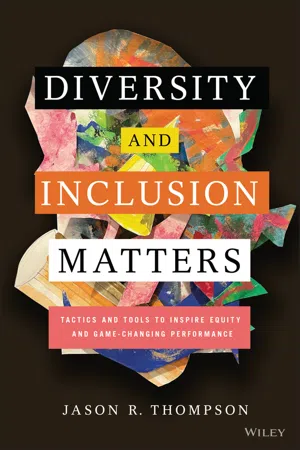
Diversity and Inclusion Matters
Tactics and Tools to Inspire Equity and Game-Changing Performance
- English
- ePUB (mobile friendly)
- Available on iOS & Android
Diversity and Inclusion Matters
Tactics and Tools to Inspire Equity and Game-Changing Performance
About This Book
Expert guidance and step-by-step instruction for building a successful diversity, equity, and inclusion initiative from scratch
In Diversity and Inclusion Matters: Tactics and Tools to Inspire Equity and Game-Changing Performance, award-winning diversity, equity, and inclusion (DE&I) expert Jason R. Thompson delivers a practical and engaging handbook for implementing a DE&I program in your organization. The CAPE technique, developed by the author, gives you a clear blueprint and the tools you'll need to make your diversity program a success.
In this book, you'll learn how to achieve early and significant wins to create the necessary and long term organizational change needed for successful DE&I programs. Find out what data you need to collect, how to analyze it, and choose the right goals for your organization. In addition, the CAPE technique will show your progress and ROI.
You will learn to:
- Manage and lead a diversity council and implement diversity initiatives in the correct order
- Get early buy-in and long-term commitment from a Chief Executive Officer by knowing what to ask for and when
- Set appropriate and realistic expectations for a DE&I program with the executive leadership team
Perfect for diversity and inclusion professionals, human resources leaders, founders, business owners, and executives, Diversity and Inclusion Matters will also earn a place in the libraries of students of human resources, leadership, management, and finance.
Frequently asked questions
Part I
The CAPE Process
Not everything that is faced can be changed, but nothing can be changed until it is faced.—James A. Baldwin
Chapter 1
How to Become an Exceptional DE&I Organization: Four Shades of Brown
Four Shades of Brown
- Diversity: Were any of the company's employees from non-dominant ethnic groups, genders, or countries? Did anyone working on this ad or product line have brown skin?
- Equity: Did any of the employees of the company realize the disparity in the ad?
- Inclusion: If so, did they believe they could speak up?
The Importance of DE&I Now
JASON-ISM

A Diverse Workforce Will Have Tension
JASON-ISM
Table of contents
- Cover
- Table of Contents
- Praise for Diversity and Inclusion Matters
- Title Page
- Copyright
- Preface
- Foreword
- Part I: The CAPE Process
- Part II: Practical Lessons Learned in DE&I Programs
- Part III: Things I Wish I Had Known
- Conclusion
- Acknowledgments
- About the Author
- Index
- End User License Agreement